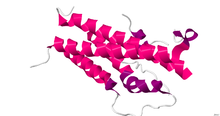Human placental lactogen
| chorionic somatomammotropin hormone 1 (human placental lactogen) | |
|---|---|

Crystal Structure of Human Placental Lactogen.
|
|
| Identifiers | |
| Symbol | CSH1 |
| Entrez | 1442 |
| HUGO | 2440 |
| OMIM | 150200 |
| RefSeq | NM_001317 |
| UniProt | Q6PF11 |
| Other data | |
| Locus | Chr. 17 q22-q24 |
| chorionic somatomammotropin hormone 2 | |
|---|---|
| Identifiers | |
| Symbol | CSH2 |
| Entrez | 1443 |
| HUGO | 2441 |
| OMIM | 118820 |
| PDB | 1Z7C |
| RefSeq | NM_020991 |
| UniProt | P01243 |
| Other data | |
| Locus | Chr. 17 q22-q24 |
Human placental lactogen (hPL), also called human chorionic somatomammotropin (HCS), is a polypeptide placental hormone, the human form of placental lactogen (chorionic somatomammotropin). Its structure and function are similar to those of human growth hormone. It modifies the metabolic state of the mother during pregnancy to facilitate the energy supply of the fetus. hPL has anti-insulin properties. hPL is a hormone secreted by the syncytiotrophoblast during pregnancy. Like human growth hormone, hPL is encoded by genes on chromosome 17q22-24. It was identified in 1963.
hPL molecular mass is 22,125 and contains single chain consisting of 191 amino acid residues that are linked by two disulfide bonds and the structure contains 8 helices. A crystal structure of hPL was determined by X-ray diffraction to a resolution of 2.0 Å.
hPL is present only during pregnancy, with maternal serum levels rising in relation to the growth of the fetus and placenta. Maximum levels are reached near term, typically to 5–7 mg/L. Higher levels are noted in patients with multiple gestation. Little hPL enters the fetal circulation. Its biological half-life is 15 minutes.
hPL affects the metabolic system of the maternal organism in the following manners:
These functions help support fetal nutrition even in the case of maternal malnutrition.
This hormone has weak actions similar to those of growth hormone, causing the formation of protein tissues in the same way that growth hormone, but 100 times more hPL than growth hormone is required to promote growth. An enhancer for the human placental lactogen gene is found 2 kb downstream of the gene and participates in the cell-specific control gene expression.
...
Wikipedia
